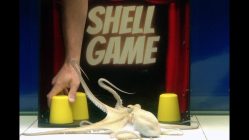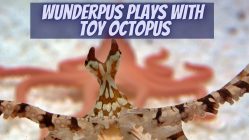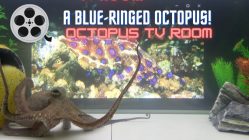The Amphioctopus Marginatus
The Amphioctopus Marginatus is more commonly known as the Coconut Octopus or else the Veined Octopus. This octopus species engages in an active style of hunting described by scientists as foraging. But the Coconut octopus of this video is in a passive hunting mode. It has collected sea shells and uses them as an improvised shelter. This is a common behavior among this species, which often collects coconut shells to use them as shields. In addition, this coconut octopus has changed the color of its skin to blend in with the color of the shell shelter. Its intention is to remain unnoticed by any passing prey. As soon as an unsuspecting victim approaches, the coconut octopus will emerge suddenly and entangle his victim with its powerful arms.
What a cunning plan indeed!
This little octopus fellow is lucky. It seems like the universe conspires to bring this crab to his hungry embrace. A sole is hunting down the crab, bringing it closer and closer to the hidden Coconut octopus. Soon, more fishes arrive at the scene and attack the crab as well. The poor crab seeks refuge in the nearby sea shells, not having the faintest clue about the even more dangerous predator lurking within them.
All Octopuses Would Kill For A Crab
Crabs are by far the favorite meal of octopuses. Although the love of octopuses for crustaceans is a well-known fact, what most people are not aware of is how the octopus manages to scrape off the flesh of the crab. The beak of the octopus is a lethal weapon. Through the beak, the octopus releases a seditive poison and immobilizes the crab. The beak is competent enough to break the shell open and sharp enough to tear the flesh of the prey apart. The mouth of the octopus also has a tongue, called the radula which is used to scrape the meat of the victim out of its shell.
An impressive part of this video is when the octopus is done with its meal. This octopus will move away from its hiding place before ejecting the remains of its meal back to the water. Sort of like taking the garbage out!
Then it will go back to its den while hungry fishes finish off the scraps of crab the octopus has left.
Walk Like a Coconut Octopus
Besides using objects to build protective gear, the Coconut octopus is a fascinating species thanks to its bipedal ability. Watch how efficiently he walks on two extended arms alone. Bipedalism enables the Coconut Octopus to carry the coconut shell on its head while walking. In this way, when seen from above, the coconut shell moving along the ocean floor does not raise suspicion from potential predators of the coconut octopus’ movements.
The poor crab did not stand a chance against this ingenious octopus that can walk on two legs.











